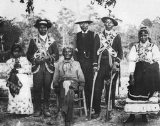
Culture of the Choctaw
Encyclopedia

Spain
Spain , officially the Kingdom of Spain languages]] under the European Charter for Regional or Minority Languages. In each of these, Spain's official name is as follows:;;;;;;), is a country and member state of the European Union located in southwestern Europe on the Iberian Peninsula...
, France
France
The French Republic , The French Republic , The French Republic , (commonly known as France , is a unitary semi-presidential republic in Western Europe with several overseas territories and islands located on other continents and in the Indian, Pacific, and Atlantic oceans. Metropolitan France...
, and England
England
England is a country that is part of the United Kingdom. It shares land borders with Scotland to the north and Wales to the west; the Irish Sea is to the north west, the Celtic Sea to the south west, with the North Sea to the east and the English Channel to the south separating it from continental...
greatly shaped it as well. The Choctaws, or Chahtas, are a Native American people originally from the Southeastern United States. They were known for their rapid incorporation of modernity, developing a written language, transitioning to yeoman
Yeoman
Yeoman refers chiefly to a free man owning his own farm, especially from the Elizabethan era to the 17th century. Work requiring a great deal of effort or labor, such as would be done by a yeoman farmer, came to be described as "yeoman's work"...
farming methods, and accepting European-American and African-Americans into their society. The Choctaw culture has it roots in the Mississippian culture
Mississippian culture
The Mississippian culture was a mound-building Native American culture that flourished in what is now the Midwestern, Eastern, and Southeastern United States from approximately 800 CE to 1500 CE, varying regionally....
era of the mound builders.
Clans
Within the Choctaws were two distinct Moieties: Imoklashas (elders) and Inhulalatas (youth). Each moiety had several clans or Iskas, it is estimated there were about 12 Iskas altogether. Identity was established first by Moiety and Iska, so a Choctaw identified himself first as Imoklasha or Inhulata and second as Choctaw. Children belonged to the Iska of their mother meaning they are matrilineal. The following were some major districts:- Okla Hannalli (people of six towns)
- Okla Tannap (people from the other side)
- Okla Fayala (people who are widely dispersed)
John Swanton writes "there are only the faintest traces of groups with truly totemic designations, the animal and plant names which occur seeming not to have had a totemic connotation."
Swanton also adds 'Adam Hodgson ... who "spoke English very well," told ... "that there were tribes or families among the Indians, somewhat similar to the Scottish clans; such as, the Panther family, the Bird family, Raccoon Family, the Wolf family."' The following are possible totemic clan designations:
- Wind
- Bear
- Deer
- Wolf
- Panther
- Holly Leaf
- Bird
- Raccoon
- Crawfish
Criminal justice
Murder was usually dealt with by revenge. Swanton writes, "Murder, i.e., intratribal man-killing, could be atoned for ordinarily only by the death of the murderer himself or some substitute acceptable to the injured family… they cherish a desire for revenge for a generation…"Stolen property was usually punishable by returning the stolen goods or other compensation. Swanton says, "thieves apprehended with the stolen property in their possession were forced to return it. If they could not produce the property, either they or their families were compelled to return goods of equal value." Theft was later punishable by a whip. Swanton states of Cushman, "for minor offenses, whipping was the punishment; fifty lashes for the first offense, one hundred for the second, and death by the rifle for the third offense ... (1899)."
Incest was considered a crime. Swanton states, "incest ... was anciently a major crime, but we have no record of the punishments inflicted on account of it."
Early religion
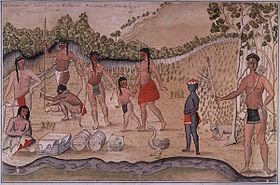
The evil spirit, or Na-lusa-chi-to ("black being") or Impashilup ("soul eater"), sought to harm people. It may appear, as told in stories, in the form of a shadow person
Shadow people
Shadow people are supernatural shadow-like humanoid figures that, according to believers, are seen mostly in peripheral vision and move quickly...
.
Prayers may have been introduced by missionaries; however, Choctaw prophets were know to address the sun. Swanton writes, "an old Choctaw informed Wright that, before the arrival of the missionaries, they had no conception of prayer. However, he adds, 'I have indeed heard it asserted by some, that anciently their hopaii, or prophets, on some occasions were accustomed to address the sun ...'"
Mythology
The Choctaw have many stories about little people. Swanton states of Halbert, "the Choctaws in Mississippi say that there is a little man, about two feet high, that dwells in the thick woods and is solitary in his habits ... he often playfully throws sticks and stones at the people ... the Indian's doctors say that Bohpoli [thrower] assists them in the manufacture of their medicines ..." The little people are said to take young children to the forest to teach them how to be medicine men.The will-o'-the-wisp
Will-o'-the-wisp
A will-o'-the-wisp or ignis fatuus , also called a "will-o'-wisp", "jack-o'-lantern" , "hinkypunk", "corpse candle", "ghost-light", "spook-light", "fairy light", "friar's lantern", "hobby lantern", "ghost orb", or simply "wisp", is a ghostly light or lights sometimes seen at night or twilight over...
was called "night-name" by the Indians and was believed to plait up the tails of horses during the night and to ride them about until they could hardly be used next day and many died from the effects.
Stories
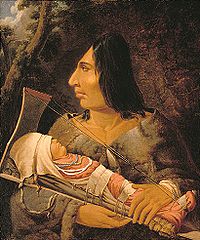
One such story of forest animals is about a possum and raccoon. Randy Jimmie and Leonard Jimmie tells,
Warfare
Choctaw warfare had many customs associated with it. Before war was declared a council was held to discuss the matter which would last about eight days. Swanton writes on Bossu's account, "The Chactas love war and have some good methods of making it. They never fight standing fixedly in one place; they flit about; they heap contempt upon their enemies without at the same time being braggarts, for when they come to grips they fight with much coolness ..." Superstition was a part of Choctaw warfare. Swanton says, "The Chactas are extremely superstitious. When they are about to go to war they consult their Manitou, which is carried by the chief. They always exhibit it on that side where they are going to march toward the enemy, the warriors standing guard about ..."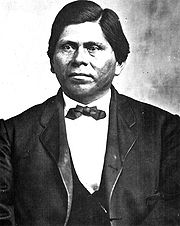
For some societies, the practice of decapitation
Decapitation
Decapitation is the separation of the head from the body. Beheading typically refers to the act of intentional decapitation, e.g., as a means of murder or execution; it may be accomplished, for example, with an axe, sword, knife, wire, or by other more sophisticated means such as a guillotine...
was considered an honor. This practice seems to be true for the Choctaw of Oskelagna. A fallen Choctaw warrior's head was brought back after a battle. Swanton says of De Lusser (1730), "there was one who brought the head of one of their people who had been killed. He threw it at my feet telling me that he was a warrior who had lost his life for the French and that it was well to weep for his death ..."
Language
The Choctaw language is a member of the Muskogean family. The language was well known among the frontiersmen, such as future U.S. President Andrew JacksonAndrew Jackson
Andrew Jackson was the seventh President of the United States . Based in frontier Tennessee, Jackson was a politician and army general who defeated the Creek Indians at the Battle of Horseshoe Bend , and the British at the Battle of New Orleans...
and William Henry Harrison
William Henry Harrison
William Henry Harrison was the ninth President of the United States , an American military officer and politician, and the first president to die in office. He was 68 years, 23 days old when elected, the oldest president elected until Ronald Reagan in 1980, and last President to be born before the...
, of the early 19th century. The language is closely related to Chickasaw and some linguists consider the two dialects a single language.
The alphabet
The written Choctaw language is based upon English characters and was developed in conujunction with the civilization program of the United States in the early 19th century. Although there are other variation of the Choctaw alphabet, the three commonly must seen are the Byington (Original), Byington/Swanton (Linguistic), and Modern.Byington (Original)

Byington/Swanton (Linguistic)

Modern

Stickball
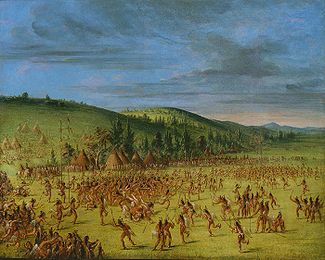
- "It is no uncommon occurrence for six or eight hundred or a thousand [!] of these young men to engage in a game of ball, with five or six times that number of spectators, of men, women, and children, surrounding the ground, and looking on..."
The goal posts could be from a few hundred feet apart to a few miles. Goal posts were sometimes located within each opposing team's village.
- "The nature of the playing field was never strictly defined. The only boundaries were the two goalposts at either end of the playing area and these could be anywhere from 100 feet (30.5 m) to five miles (8 km) apart, as was the case in one game in the 19th century." (Kendall Blanchard, The Mississippi Choctaws at Play: The Serious Side of Leisure)
The Mississippi Band of Choctaw Indians play stickball today in the 21st century. Every year at the Choctaw Indian Fair
Choctaw Indian Fair
For centuries the Mississippi Choctaws have gathered at the ripening of the first corn. This gathering was called "The New Corn Ceremony" or "Green Corn Festival." The present day Choctaw Indian Fair has roots in this ancient celebration....
near Philadelphia, Mississippi stickball can be seen played on a modern day football field.

